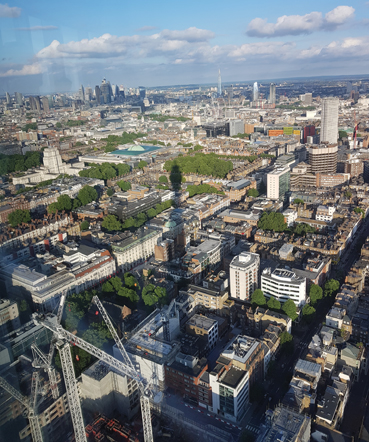If private security people think of security management in the past at all, it may be of nightwatchmen around braziers – of security, if it was done at all in the old days, done in a primitive and even barbaric way – such as a guard dog left at a warehouse or other site to be guarded without a handler or even without food, to make it angrier against any intruders. While night guards did warm their hands around a fire, some people in what was a fast-growing and developing industry were articulate and intelligent, and doing exciting and important work – as they had to be, against the threats of the day. Three examples of security management from 50 years ago follow. First, a physical security upgrade of one of London’s newest and most fashionable landmarks.
In June 1970, the London Telecommunications Region of the GPO – for in those days, the Post Office was also in charge of the country’s telephones – raised the question of security at the Post Office Tower: “Recent events and realisation that the Tower is a possible target for demonstrations etc have understandably revived LTR fears. Mr Heath has had considerable experience of this sort of work abroad and expressed himself as willing to undertake a review of security arrangements and to make recommendations for consideration by LTR.” Mr Heath was not the incoming Conservative Prime Minister, by DH Heath, the Post Office’s senior architect.
As DM McIntyre of LTR put it in a letter to another architect, later in June 1970, ‘the value of the Tower and its equipment to the country’s communications cannot be over-emphasised and we must take reasonable action to improve the security of the entrance’ – short of providing armed guards – ‘and we would be glad to have your outline proposals’. Likely cost was £5000; in 21st century money, a six-figure sum.
Mr Heath first enters the file – CM 22/88 at the National Archives at Kew – on July 1, 1970 with the point that you could not have ‘total security’, owing to public access to viewing galleries and the (famous) restaurant. He listed points to strengthen. The rear entrance, at Cleveland Mews, was the goods entrance and the way in to garages below ground. That was guarded by a drop bar, operated by a watchman, in a small office. Separately, an office manager was getting a larger office. If so, they could fit roller shutters to the building extension; and the file actually opens with a brochure for Haskins shutters, as installed at Gatwick airport. Also proposed for adding was steel mesh, over the voids to the basement, that ‘would seal off this entrance from intruders’.
Cleveland Street was the staff entrance. If, Mr Heath imagined, ‘overrun by rioters, this would provide easy access to both sections and particularly to the vital section of generating equipment below the Tower’. That is an interesting sign of what threats the Post Office imagined its flagship building was facing.
Heath recommended two steel doors, ‘with simple shoot bolts’. These would seal off both sides of the entrance in time of ‘civil strife’. Heath admitted that the entrance foyer and rooms off the foyer were vulnerable, but it was impossible to secure the actual entrance ‘without very heavy and unsightly precautions’. Mr Heath was indeed experienced, insightful and nuanced in his security surveying. He proposed replacing plate glass of ground floor windows with wired, polished plate glass; ‘this is an improvement, but is not fully secure as this glass can be smashed out to gain entrance to the building’. Heath recommended adding bars, inside the windows.
Next: how the plans fared with the GLC: click here.
Picture by Mark Rowe; view from BT Tower, summer evening, looking east.










